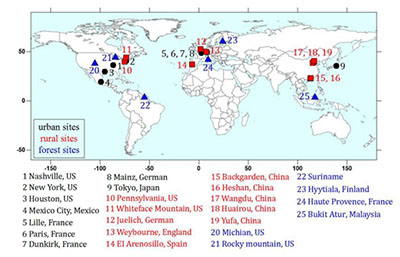摘要/Abstract

OH自由基作为大气氧化性的重要衡量指标,其去除途径仍无法完全准确地被量化,OH自由基总反应性作为描述OH自由基总去除能力和大气氧化性的重要参数,是OH自由基收支闭合分析的关键参数.OH自由基活性高、寿命短,其反应活性的准确测量具有挑战性.本综述总结了OH自由基总反应性的实地测量方法,并对移动注射-激光诱导荧光法、闪光光解-激光诱导荧光法、化学离子质谱法和相对反应活性法四种方法的测量原理、仪器架构等进行了系统阐述,综合分析认为闪光光解-激光诱导荧光法是目前OH自由基总反应性测量技术的发展方向.同时进一步总结了OH自由基总反应性在城市、森林和郊区等大气环境下的化学行为等,并对研究难点和可能的重点研究方向进行了探讨.
关键词: OH自由基总反应性, 测量方法, 外场观测, 活性组成, 活性缺失
Observations of OH Radical Reactivity in Field Studies Yang, Xinpinga,b Wang, Haichaoa,b Tan, Zhaofenga,b,c Lu, Keding*,a,b Zhang, Yuanhang*,a,b,d,e (a State Key Joint Laboratory of Environmental Simulation and Pollution Control, College of Environmental Sciences and Engineering, Peking University, Beijing 100871) (b International Joint Research Center for Atmospheric Research, Peking University, Beijing 100871) (c Institute of Energy and Climate Research, IEK-8:Troposphere, Forschungszentrum Jülich GmbH, Jülich, Germany 52425) (d CAS Center for Excellence in Regional Atmospheric Environment, Chinese Academy of Sciences, Xiamen 361021) (e Beijing Innovation Center for Engineering Sciences and Advanced Technology, Peking University, Beijing 100871) Abstract The hydroxyl radical (OH) is the main source of atmospheric oxidation capacity, which oxidizes the primary pollutants into the secondary pollutants. Therefore, the measurements and characterization of source and sink of OH radical are critical to understand the formation mechanism of regional secondary pollution. However, the removal routes of OH radical still cannot be quantified accurately. OH radical reactivity can describe the OH total loss rate and the atmospheric oxidation, thus playing an important role in the OH budget analysis. The OH radical reactivity is defined as the total pseudo first-order rate coefficient for all atmospheric reactions of OH in an air parcel. It is challenging to accurately measure the OH radical reactivity due to the high activity and short life of OH radical. In this paper, we summarized all kinds of measurement techniques used in the field observations of OH radical reactivity, including Total OH Loss-rate Measurement (TOHLM), Laser flash Photolysis-Laser Induced Fluorescence (LP-LIF), Chemical Ionisation Mass Spectrometry (CIMS) and Comparative Reactivity Method (CRM). The techniques were reviewed on the aspects of measurement principles, instrument modules, and so on. Overall, LP-LIF is proposed to be the best technical approach. In addition, the measured OH radical reactivity and the major scientific findings of corresponding measurement campaigns conducted in typical tropospheric conditions as urban, forest and rural environments, etc. were outlined. The OH radical reactivity varies significantly in different conditions, ranging from less than 10 per second to hundreds. Comparison of measured OH radical reactivity and the calculated or modeling results reveals a significant missing reactivity, ranging from 20% to over 80% in some environments. Depending on the emission and pollution characteristics of the field observation sites, the sources of missing reactivity are generally attributed to the undetected or unknown organic species, i.e. primary organic species, secondary organic species or a combination of both. The accurate observation and the numerical modeling of the OH radical reactivity can provide a possibility for achieving numerical closure study of ROx radicals. Finally, we discussed the current research difficulties and possible new directions for future studies of the OH radical reactivity.
Key words: OH radical reactivity, measurement techniques, field observation, compositions of OH radical reactivity, missing reactivity
PDF全文下载地址:
点我下载PDF
